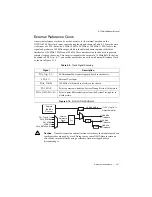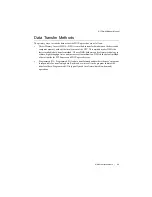
© National Instruments
|
2-17
External Reference Clock
An external reference clock can be used as a source for the internal timebase on the
NI PXIe-4300. This clock can be sourced using the signals shown in Table 2-5. Since the clock
is the input of a PLL, it must be 5 MHz, 10 MHz, 20 MHz, or 100 MHz. A PLL locks to the
signal and produces a 100 MHz output, which is then divided down to produce the three
timebases of 100 MHz, 20 MHz and 100 kHz. These timebases can then be used to generate
sample clocks on the device. This circuit also enables the output of a 10 MHz RefClk that can
be routed to PXI_Trig <0..7> and used by another device as its own External Reference Clock
as shown in Figure 2-10.
Figure 2-10.
External Clock Reference
Caution
Do not disconnect an external reference clock once the modules have been
synchronized or are used by a task. Doing so may cause NI-DAQmx to return an
error. Make sure that all tasks using a reference clock are stopped before
disconnecting it.
Table 2-5.
Clock Signal Sourcing
Signal
Description
PXI_Trig<0..7>
Bi-Directional bus connecting each board in the chassis.
PFI<0, 1>
External User Input
PXIe_Clk100
100 MHz clock routed to all slots in the chassis.
PXI_STAR
Point to point route from the System Timing Slot to all other slots.
PXIe_DSTAR<A, B>
Point to point differential routes from the System Timing Slot to
all other slots.
Extern
a
l
Reference
Clock
÷
200
On
b
o
a
rd
100 MHz
O
s
cill
a
tor
PLL
÷
5
÷
10
PXI_Trig <0..7>
PXIe_CLK100
PXI_
S
TAR
PFI<0, 1>
PXIe_D
S
TAR<A,B>
10 MHz RefClk
(To PXI_Trig <0..7>
O
u
tp
u
t
S
elector
s
)
100 MHz
Time
bas
e
20 MHz
Time
bas
e
100 kHz
Time
bas
e


























